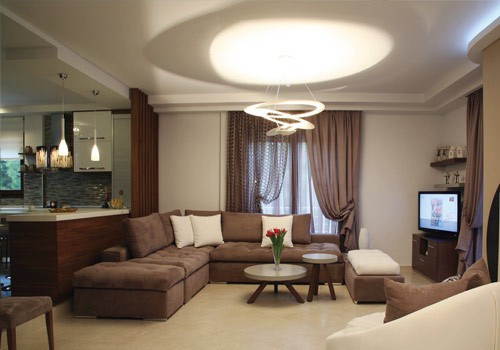Η Yayoi Kusama γεννήθηκε τον Μάρτιο του 1929 στο Ματσουμότο της Ιαπωνίας, σε μια εύπορη και συντηρητική οικογένεια η οποία δεν εκτιμούσε καθόλου τα ποικίλα ταλέντα της. Σύντομα άρχισε να έχει δείγματα ψυχασθένειας και σύμφωνα με δικά της λεγόμενα νόμιζε πως τα λουλούδια δίπλα στο ποτάμι είχαν ανθρώπινες εκφράσεις. Οι παραισθήσεις της ήταν γεμάτες από χρωματιστές βούλες.Οι εμμονές, οι τάσεις αυτοκτονίας, οι ψευδαισθήσεις θα την ακολουθούσαν σε όλη της τη ζωή. Τα επαναλαμβανόμενα μοτίβα και τα απόκρυφα σεξουαλικά στοιχεία θα γινόντουσαν τα χαρακτηριστικά των έργων της.
Σπούδασε στο Specialist School of Arts του Κιότο Nihonga που είναι ο συνδυασμός ιαπωνικής ζωγραφικής με σύγχρονες δυτικές επιρροές.
Τίποτε δεν μπορούσε να την σταματήσει, ούτε καν η διαταραχή της, από το να αποδράσει από την οικογένειά της στη Νέα Υόρκη. Εκεί αφοσιώθηκε στα έργα της, με τα πουά. «Έχει τη μορφή του ήλιου, που είναι σύμβολο ενέργειας, σύμβολο ζωής και διαβίωσης. Έχει τη μορφή της σελήνης η οποία είναι ήρεμη» δήλωνε. Τα πουά, το σήμα κατατεθέν της, άρχισαν να καλύπτουν όχι μόνον επιφάνειες μεμονωμένες αλλά και ολόκληρους τοίχους και δωμάτια σε μια παράλογη σειρά που οδηγούν στο άπειρο. Το αποτέλεσμα ήταν ένα παραισθησιογόνο περιβάλλον που την κατέκλυζε. Η καλλιτέχνις, με τον τρόπο αυτό έγινε environmental artist, σπάζοντας τα όρια της έννοιας του «χώρου».
Έφτιαξε πίνακες, γλυπτά, installations, ασχολήθηκε με την performance art και την action art. Τη δεκαετία του ’60 διοργάνωνε «Body Festivals» στο πλαίσιο των οποίων ζωγράφιζε τα περίφημα πουά της πάνω σε γυμνά σώματα. Χρησιμοποιώντας με μοναδικό τρόπο τις φοβίες και τις τραυματικές εμπειρίες της δημιούργησε μία απίστευτα παραγωγική τέχνη. Ιδιαίτερα εντυπωσιακά είναι τα installations που χρησιμοποιούν καθρέπτες και φώτα, πολλαπλασιάζοντας τις βούλες στο άπειρο.
Το 1966 συμμετέχει στη Μπιενάλε της Βενετίας με το Narcissus Garden, ένα installation από εκατοντάδες ανακλώμενες μεταλλικές σφαίρες, προσκαλώντας τον επισκέπτη να μπει μέσα στο ίδιο το έργο και να βιώσει τα δικά του παραισθησιογόνα συναισθήματα.
Τη δεκαετία του ‘70 επιστρέφει στην Ιαπωνία, και αποφασίζει να εισαχθεί σε ψυχιατρική κλινική, όπου με δική της επιλογή, διαμένει μόνιμα πια σε ανοιχτή πτέρυγα. Εργάζεται ανελλιπώς καθημερινά και ακατάπαυστα δημιουργώντας τα διάσημα πλέον έργα της, με πινέλα, με φώτα LED, με ύφασμα, με μπρούντζο. Έχει δημοσιέυσει πολλά βιβλία, ανθολογίες και νουβέλες. Τα τελευταία χρόνια, τα social media έπαιξαν πολύ σημαντικό ρόλο ώστε η καλλιτέχνης να βρεθεί και πάλι στο επίκεντρο, με τον κόσμο να περιμένει για ώρες στην ουρά ώστε να αποκτήσει μια πολυπόθητη selfie σε ένα από τα δωμάτια με τους καθρέφτες.
My art originates from hallucinations only I can see. I translate the hallucinations and obsessional images that plague me into sculptures and paintings
Yayoi Kusama was born in March 1929 in Matsumoto, Japan into a wealthy but conservative family which did not appreciate her various talents at all.
She soon started to exhibit mental illness symptoms and according to her, the flowers by the river had human expressions. Her hallucinations were full of colorful dots. Obsession, suicidal tendencies, illusions would follow her throughout her life. Repetitive patterns and ‘private’ sexual elements would characterize her works.
She studied at Kyoto School of Arts and Crafts in Nihonga, which is the combination of Japanese painting with contemporary west influences.
Not a single thing could have stopped her, not even her mental disorder, from escaping from her family and going to New York. It was there she dedicated herself to her polka-dot works: “It has the same shape as the sun, the symbol of energy, of life, of living. It has the same shape as the calm moon”, she used to say. Polka dots, her trademark, started to cover not only single surfaces, but whole walls and rooms in an irrational order leading to infinity. The result was the creation of a hallucinogenic environment which overwhelmed her. This way, the artist became an Environmental Artist, breaking the limits of “space”.
She has created paintings, sculptures, installations, and she has also engaged in performance and action art. During the 1960s, she used to organize “Body Festivals” where she painted her famous polka-dots on naked bodies. Using her phobias and traumatizing experiences in a unique way, she managed to create unbelievably productive art. Her installations that include mirrors and lights are really impressive as her dots are infinitely multiplied.
In 1966, she participates in Venice Biennale with her “Narcissus Garden”, an installation made of hundreds of shimmering mirrored balls, challenging visitors to enter the work and experience hallucinated feelings themselves.
In the 1970’s, she goes back to Japan, and decides to admit herself to a psychiatric clinic, where she voluntarily lives to this day in an open ward. She works incessantly, without falling, every single day creating her now famous works using brushes, LED lights, fabric and bronze. She has published several books, anthologies and novels. In recent years, social media has played an important role in bringing the Artist back to the centre of attention, with people queuing for hours to take a selfie picture in one of the mirror rooms.
If it were not for art, I would have killed myself a long time ago!

Η Sarah Suzuki, επιμελήτρια στο ΜΟΜΑ, η εικονογράφος Ellen Weinstein και ο εκδότης Charles Kim, δημιούργησαν ένα παιδικό βιβλίο με θέμα τη ζωή της Kusama με τίτλο, «Yayoi Kusama: Από εδώ έως το Άπειρο» που απευθύνεται σε παιδιά από τέσσερα έως οκτώ ετών
Sarah Suzuki, curator at MOMA, illustrator Ellen Weinstein and publisher Charles Kim, created a children’s book on Kusama’s life entitled “Yayoi Kusama: From Here to the Infinity” addressed to children aged four to eight


















 paidiko-epiplo
paidiko-epiplo trelight
trelight keller-karantoni
keller-karantoni lusso
lusso matt-royal
matt-royal
 Dreambeds
Dreambeds OROGENIO
OROGENIO massif-epiplo
massif-epiplo mpallas
mpallas
 epiplostyle
epiplostyle






























































































